Douglas TBD Devastator - WWII Navy Torpedo-Bomber
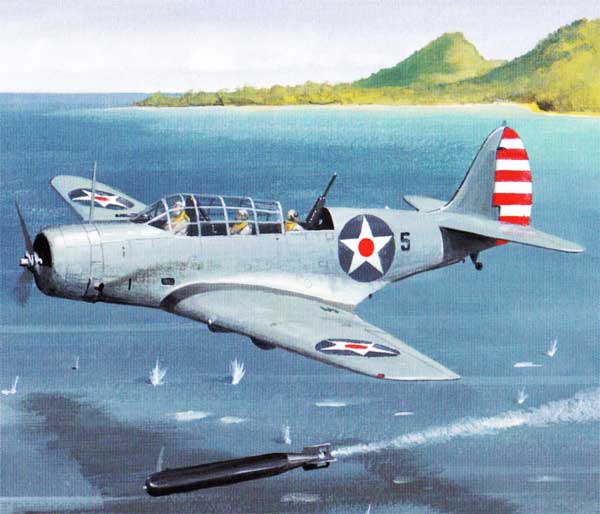
The TBD Devastator was the US Navy first monoplane torpedo-bomber, and it embodied many new features. Combat tactics changed little from the biplane era, however. An effective torpedo attack requires a slow and steady approach, and this made the Devastators easy targets. Once the TBD had braved fighters and ships' guns of all calibers, the success of its attack depended on whether the torpedo ran true and if it actually exploded against the target. US wartime torpedoes were notoriously ineffective. Although Devastators sank one Japanese carrier at Coral Sea, the Battle of Midway in June 1942 saw the TBD force wiped out without inflicting damage on the Japanese. Only five of the 41 TBDs involved in the battle made it back and the battle left fewer than 20 TBDs in the inventory. By August 1942 they were withdrawn from the front line.
Apart from the fact that it was slow the Devastator's main drawback was its lack of defensive firepower. The single 0.30-inch machine gun mounted in its rear cockpit was completely inadequate against the heavy-calibre weapons of the Japanese Mitsubishi A6M Zero fighters, which accounted for the majority of the TBD losses in the Battle of Midway. Subsequent US Navy attack aircraft were much better armed, as Japanese fighter pilots often found to their cost.
This American torpedo bomber is remembered mostly for a tragic reason - the Douglas TBD Devastator fell in flames at Midway, where an entire squadron was lost in a matter of minutes. The Devastator was perfectly acceptable aircraft by prewar standards, but it came on the scene when change was occurring rapidly. By the time men and machines were pitted in combat in the Pacific, the TBD was no longer an effective warplane.
Douglas TBD Devastator
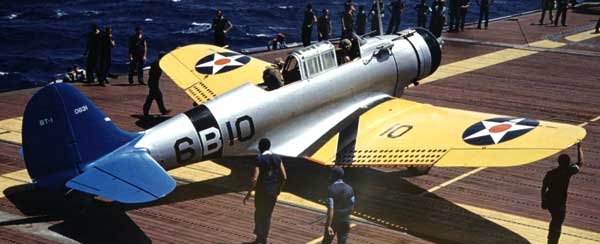
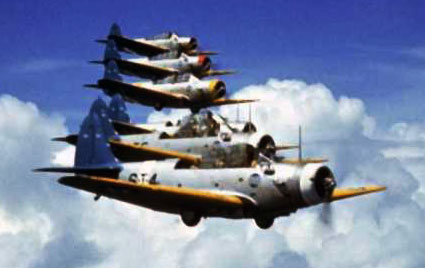 Early in 1934 the US Navy initiated a design competition for the
development of a new torpedo-bomber for service on board US
aircraft carriers and, in particular, for USS Ranger, which was
due to be commissioned that year. From the proposals received,
prototypes were ordered from Douglas and the Great Lakes Aircraft
Corporation; the Douglas XTBD-I represented the first carrier-based
monoplane to be produced for the US Navy. On the other hand, the
Great Lakes XTBG-1, of which only a single prototype was built, was
the last biplane in the torpedo-bomber category to be procured by the
US Navy.
Early in 1934 the US Navy initiated a design competition for the
development of a new torpedo-bomber for service on board US
aircraft carriers and, in particular, for USS Ranger, which was
due to be commissioned that year. From the proposals received,
prototypes were ordered from Douglas and the Great Lakes Aircraft
Corporation; the Douglas XTBD-I represented the first carrier-based
monoplane to be produced for the US Navy. On the other hand, the
Great Lakes XTBG-1, of which only a single prototype was built, was
the last biplane in the torpedo-bomber category to be procured by the
US Navy.
The prototype XTBD-1, which flew for the first time on April 15, 1935, was of fairly conventional configuration and construction. The 1ow-set cantilever monoplane wing could be folded mechanically at approximately mid-span and construction was all-metal, except that the rudder and elevators were fabric-covered. The deep fuselage housed an internal weapons bay which could accommodate a torpedo or a large armor-piercing bomb. Only the main units of the tail-wheel-type landing gear were semi-retractable, the mainwheels being half exposed below the wing's lower surface when retracted. An arrester hook was mounted forward of the tailwheel. Powerplant of the prototype consisted of an 800-hp Pratt & Whitney XR-1830-60 radial engine. Accommodation was provided for a crew of three (pilot, bomb-aimer/navigator and gunner) housed beneath a long transparent cockpit enclosure.
Initial testing of the prototype went so well that within nine days of the first flight Douglas was able to hand it over to the US Navy for service trials. These were carried out over a period of nine months and resulted in contracts for a total of 1,29 examples of the TBD-1 Devastator production model, the first awarded to Douglas on February 3, 1936. When delivery of these aircraft began, on June 25, 1937 the US Navy had in its possession what was then, unquestionably, the most advanced torpedo-bomber in the world.
The first US Navy squadron to receive its TBD-1s, on October 5, 1937, was VT-3. Squadrons VT-2, VT-5, and VT 6 were equipped during the following year. The TBD-1 remained in first-line service with the US Navy until after the Battle of Midway. The main clash of this battle came on June 4, 1942, when 35 TBD-1s were shot to pieces, caught between blistering anti-aircraft fire and the guns of Mitsubishi A6M Zero naval fighters. Soon afterwards it was withdrawn from combat service, no longer able to survive against modern fighter and anti-aircraft opposition. Devastators were used for some time afterwards on communications and training duties.
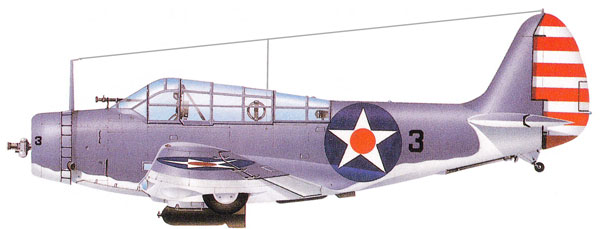
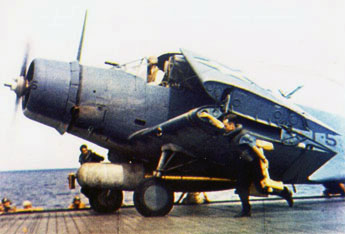 The Douglas TBD Devastator was the first all-metal low-wing
monoplane with retractable landing gear to go into service in the
U.S. Navy. However, although advanced at the time that occur-
red, this sturdy and reliable torpedo plane was virtually out-of-date
when the war broke out and it found itself fighting with a clear
disadvantage compared to the fierce fighters of the enemy. Proof
of its being obsolete was dramatically provided on June 4, 1942,
during the Battle of Midway: 15 TBD-1 s that had taken off from
the aircraft carrier Hornet to attack the Japanese naval force were
literally wiped out (only one managed to return to the carrier) by
antiaircraft fire and by the violent counterattack of the Mitsubishi
A6M Zeros, against which they were practically defenseless. During the next two days of battle, the fate of the entire torpedo plane
force on the carriers Yorktown, Enterprise, and Hornet was seal-
ed, and it was reduced from a total of 41 aircraft to five. This
episode in the air-sea battle in the Pacific also marked the end
of the Devastator's operative career, which had commenced in
November 1937 on board the aircraft carrier Saratoga. The total
number of aircraft produced was not very high: 129 planes of a
single prodUction series version, designated TBD-1.
The Douglas TBD Devastator was the first all-metal low-wing
monoplane with retractable landing gear to go into service in the
U.S. Navy. However, although advanced at the time that occur-
red, this sturdy and reliable torpedo plane was virtually out-of-date
when the war broke out and it found itself fighting with a clear
disadvantage compared to the fierce fighters of the enemy. Proof
of its being obsolete was dramatically provided on June 4, 1942,
during the Battle of Midway: 15 TBD-1 s that had taken off from
the aircraft carrier Hornet to attack the Japanese naval force were
literally wiped out (only one managed to return to the carrier) by
antiaircraft fire and by the violent counterattack of the Mitsubishi
A6M Zeros, against which they were practically defenseless. During the next two days of battle, the fate of the entire torpedo plane
force on the carriers Yorktown, Enterprise, and Hornet was seal-
ed, and it was reduced from a total of 41 aircraft to five. This
episode in the air-sea battle in the Pacific also marked the end
of the Devastator's operative career, which had commenced in
November 1937 on board the aircraft carrier Saratoga. The total
number of aircraft produced was not very high: 129 planes of a
single prodUction series version, designated TBD-1.
The project originated in 1934, on the basis of specifications issued by the U.S. Navy calling on manufacturers to design a new carrier-based torpedo plane to operate from the aircraft carriers then being built. As well as Douglas, several other companies participated: prototypes were also prepared by the Great Lakes Air- craft Corporation of Cleveland (XTBG-1 , a biplane) and by the Hall Aluminum Aircraft Corporation of Bristol, Pennsylvania (XPTBH-2, a high-wing seaplane). Among the competitors, the XTBD-1 submitted by Douglas clearly appeared the most potent and technologically advanced. lt was a low-wing monoplane (the cantilever wings could be folded back by means of hydraulic controls), with all-metal airframe and covering (apart from the rudder and the elevator, which were fabric covered), The main landing gear was partially retractable (the wheels protruding half-way, to facilitate emergency landing). The prototype was powered by an 811hp Pratt & Whitney XR-1830-60 radial engine, and the three- man crew was housed in a single enclosed cockpit, The aircraft's defensive armament was to consist of two machine guns, one fix- ed forward one, and another flexible one for the defense of the side and rear sections, and of a 1,000 lb bomb load or a torpedo.
The prototype took to the air for the first time on April15, 1935, and it began a series of flight tests and operative evaluations at the Anacostia naval base immediately after. This phase proved to be particularly long, and several modifications were carried out, the principal ones being the substitution of the engine, the installation of a better and more aerodynamic engine cowling, and the redesigning of the crew's cockpit. The latter was provided with a different hood, carefully studied to improve the pilot's visibility during landing on deck. The first contract was signed in February 1936, and production commenced immediately after. Deliveries began on June 25, the following year.
When the United States entered the war, 100 TBD-1s were in service, although only 69 could be considered operative. ln addition to the Battle of Midway, this torpedo plane took part in all the air-sea operations involving the United States during the first six months of the war and, in spite of everything, generally produced satisfactory results in the role of a traditional bomber.
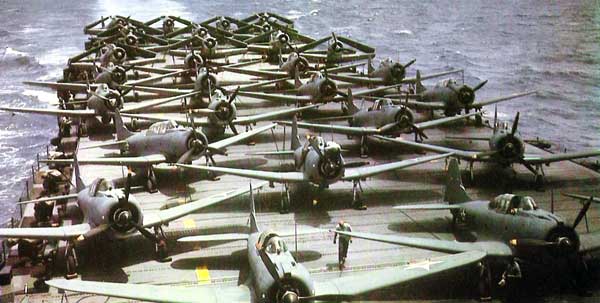
History:
First flight (XTBD-1) January 1935; production delivery June 25, 1937. In the early 1930s the US Navy ordered new aircraft carriers, the Ranger, Yorktown and Enterprise. Among their complement were to be squadrons of torpedo bombers and on June 30, l 934 orders were placed for two prototypes of rival designs. One was the Great Lakes XTBD-1. rather similar to the later British Sword fish. Tire other was the first cantilever monoplane designed for such a duty, the Douglas XTBD-1 The monoplane started with the drawback of being radically new, though the wing was very thick, the retracted main wheels protruded far enough for safe landings and the landing speed was only 59 mph. The large canopy over the pilot, radio operator and gunner opened into six sections for "open cockpit" vision, and the all-round performance of the monoplane was superior.
Despite competition from another monoplane contender, on 3 February 1936, the Douglas won the production order for 110 aircraft, then the largest peace time order for aircraft placed by the US Navy. The production TBD had a taller canopy with crash pylon, power-folding wings and other changes. Altogether 129 were delivered, and over 100 were still the only carrier based torpedo bombers in US service at the time of Pearl Harbor. Named Devastator. they immediately went into violent action. bombing and torpedoing almost on a round-the clock basis. The middle crewmember aimed the torpedo sighting through doors in the belly from a prone position. In the Marshalls and Gilberts these aircraft proved formidable. but they were obsolescent and in the Battle of Midway 35 were shot down by flak and Zeros in a single action. The Devastator was soon afterwards replaced by the Grumman Avenger.
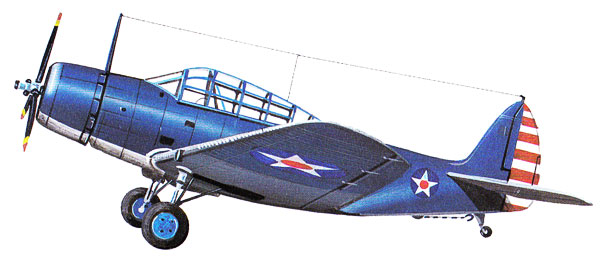
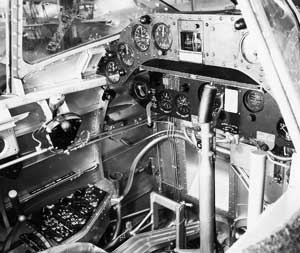 |
The Cockpit of a Douglas TBD Devastator. |
Specifications
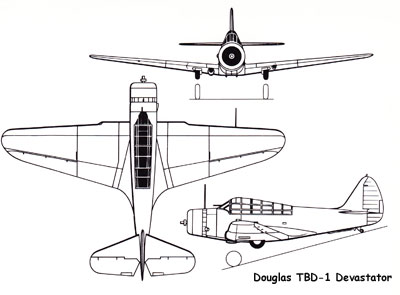 |
Crew: Three: Pilot, Torpedo |
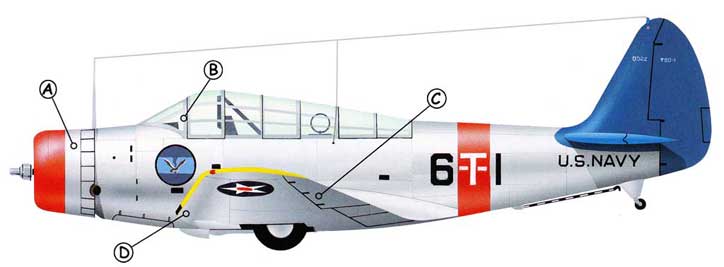 |
|||
| A: The R-1830 variant of Pratt & Whitney's well-known Twin Wasp powered the TBD. This powerplant was also widely used in other types, such as the C-47 Skytrain. | B: Devastators were manned by three crew: a pilot, navigator/torpedo officer and gunner. The latter sat at the rear of the cockpit "glasshouse" and fired a 7.62-mm (.30-cal.) machine gun. A forward firing machine gun was also fitted in the inner port wing. | C: Though fitted on the production line with wing flotation bags to allow the crew time to escape the aircraft if it ditched, these were removed in wartime. This ensured that the TBD would sink, taking its advanced Norden bombsight with it. | D: While the TBD boasted a powered wing folding mechanism, this lacked sufficient power to move the wings in a strong cross wind, necessitating a 'group effort' by ground handlers. |
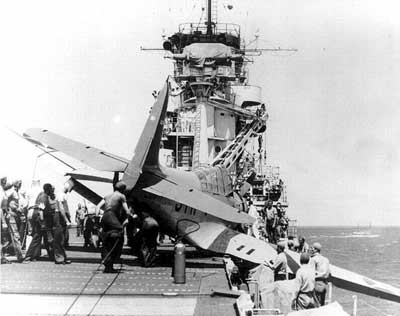 |
Douglas TBD-1 Devastator of Torpedo Squadron Five (VT-5) in the starboard catwalk of USS Yorktown, September 3, 1940, following a landing accident. Pilot was Electrician's Mate First Class (Naval Aviation Pilot) C.M. O'Brien. Ultimately assigned to Torpedo Squadron Eight (VT-8), This aircraft was lost on June 4, 1942 during the Battle of Midway. |

